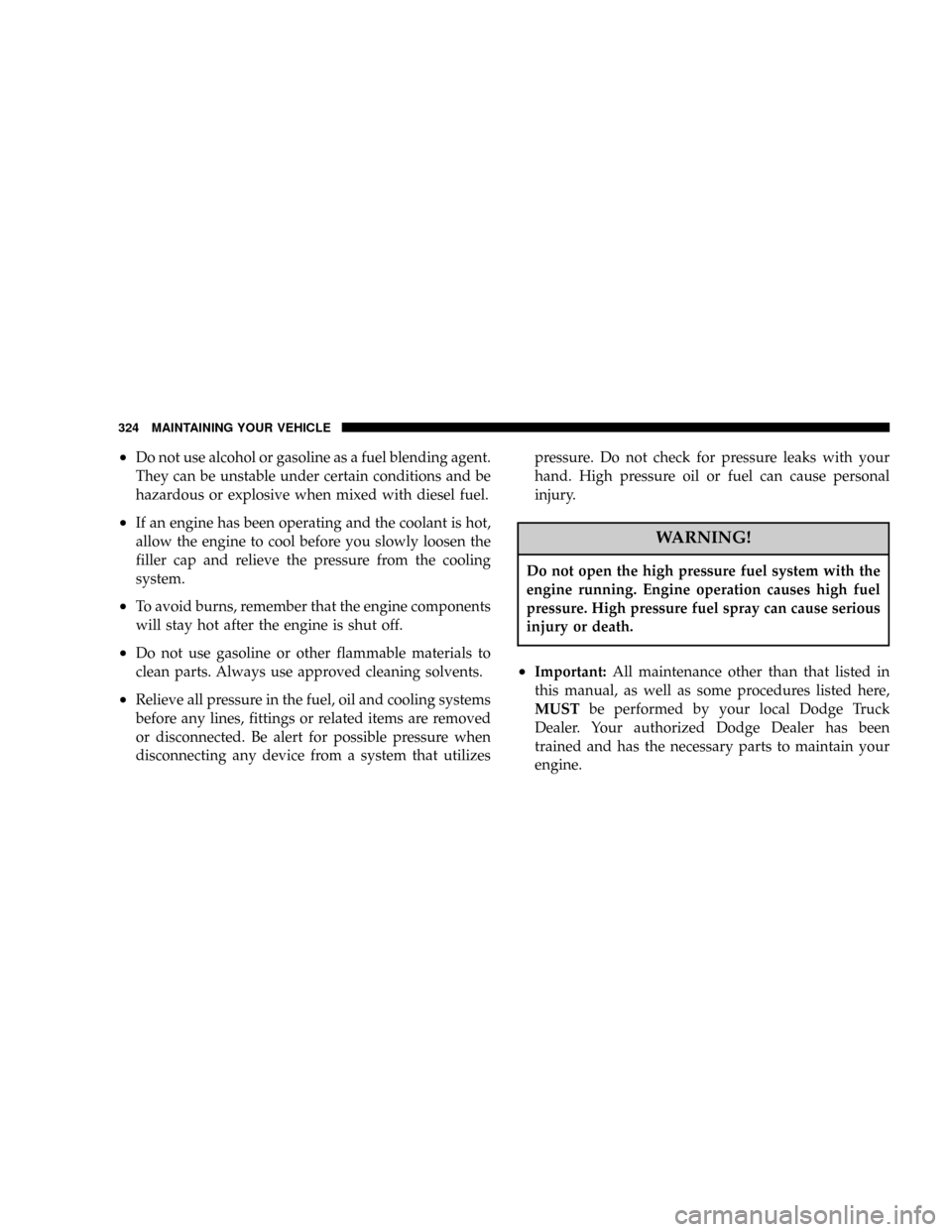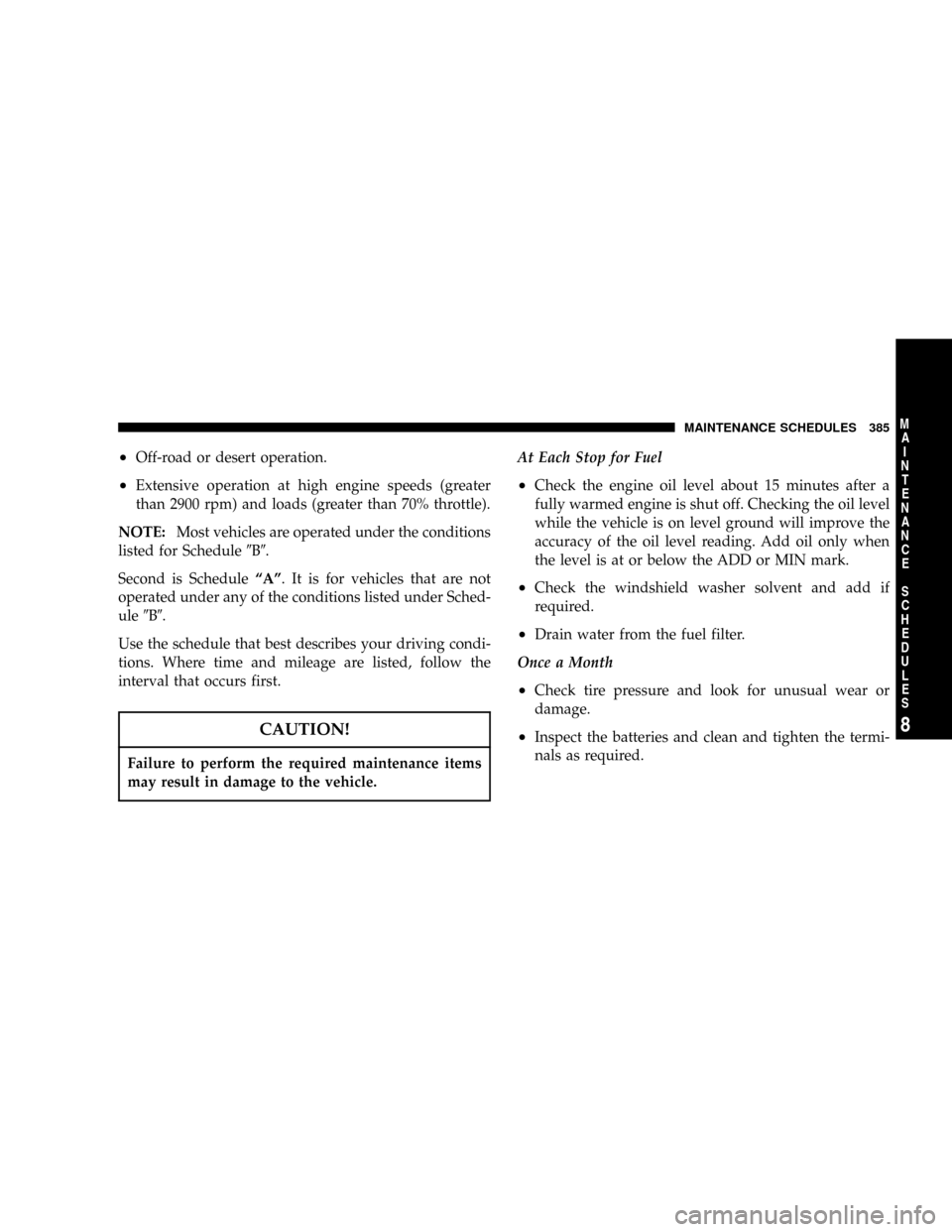Page 306 of 426

hand, it may be necessary to use the jack drive tube in
order to lower the jack. Stow the replaced tire, jack, and
tools as previously described.
9. Adjust the tire pressure when possible.
NOTE:Do not oil wheel studs. For chrome wheels, do
not substitute with chrome plated wheel nuts.
Hub Caps
The hub caps must be removed before raising the vehicle
off the ground.
For 2500/3500 single rear wheel (SRW) models, use the
blade on the end of the lug wrench to pry the cap off.
On 3500 models with dual rear wheels (DRW), you must
first remove the hub caps. The jack handle driver has a
hook at one end that will fit in the pry off notch of the
rear hub caps. Position the hook and pull out on the
ratchet firmly. The cap should pop off. The wheel skins
can now be removed. For the front hub cap on 3500models use the blade on the end of the lug wrench to pry
the caps off. The wheel skin can now be removed.
You must use the flat end of the lug wrench to pry off the
wheel skins. Insert the flat tip completely and using a
back and forth motion, loosen the wheel skin. Repeat this
procedure around the tire until the skin pops off.
Replace the wheel skins first using a rubber mallet. When
replacing the hub caps, tilt the cap retainer over the
lugnut bolt circle and strike the high side down with a
rubber mallet. Be sure that the hub caps and wheel skins
are firmly seated around the wheel.
8-Stud Ð Dual Rear Wheels
Dual wheels are flat mounted, center piloted. The lug
nuts are a two piece assembly. When the tires are being
rotated or replaced, clean these lug nuts and add 2 drops
of oil at the interface between the hex and the washer.
306 WHAT TO DO IN EMERGENCIES
Page 324 of 426

²Do not use alcohol or gasoline as a fuel blending agent.
They can be unstable under certain conditions and be
hazardous or explosive when mixed with diesel fuel.
²If an engine has been operating and the coolant is hot,
allow the engine to cool before you slowly loosen the
filler cap and relieve the pressure from the cooling
system.
²To avoid burns, remember that the engine components
will stay hot after the engine is shut off.
²Do not use gasoline or other flammable materials to
clean parts. Always use approved cleaning solvents.
²Relieve all pressure in the fuel, oil and cooling systems
before any lines, fittings or related items are removed
or disconnected. Be alert for possible pressure when
disconnecting any device from a system that utilizespressure. Do not check for pressure leaks with your
hand. High pressure oil or fuel can cause personal
injury.
WARNING!
Do not open the high pressure fuel system with the
engine running. Engine operation causes high fuel
pressure. High pressure fuel spray can cause serious
injury or death.
²Important:All maintenance other than that listed in
this manual, as well as some procedures listed here,
MUSTbe performed by your local Dodge Truck
Dealer. Your authorized Dodge Dealer has been
trained and has the necessary parts to maintain your
engine.
324 MAINTAINING YOUR VEHICLE
Page 326 of 426
Checking the vehicle while it's on level ground will also
improve the accuracy of the oil level readings. Add oil
only when the level on the dipstick is below the ªADDº
mark. The total capacity from the low mark to the high
mark is 2 quarts (1.9 liters).
Never operate the engine with oil level below the ªADDº
mark or above the upper ªSAFEº mark.Change Engine Oil
CAUTION!
Overfilling or underfilling the crankcase will cause
oil aeration or loss of oil pressure. This could dam-
age your engine.
Road conditions as well as your kind of driving affect the
interval at which your oil should be changed. Check the
following to determine if any apply to you:
²Frequent short trips where the engine does not achieve
full operating temperature (operating temperature de-
fined as 190É F (66É C ) coolant temperature).
²Extensive engine idling (over 10 minutes per hour of
operation) at ambient temperatures less than 32É F (0É
C).
326 MAINTAINING YOUR VEHICLE
Page 343 of 426

Cooling System
Cooling System Maintenance
At the intervals shown in the Maintenance Schedules
Section of the manual, the system should be drained,
flushed and filled.
Inspection
Coolant protection checks should be made every 12
months (prior to the onset of freezing weather, where
applicable). If coolant is dirty or rusty in appearance, the
system should be drained, flushed and refilled with fresh
coolant as specified.
Inspect the entire cooling system for leaks. Check the face
of the radiator for any accumulation of bugs, leaves, or
other foreign matter. If dirty, clean the radiator core with
a garden hose. With the engine OFF, gently spray water
from the back of the radiator core. Check coolant bottle
tube for condition and tightness of connections at coolant
bottle and radiator.Check the coolant pressure cap and coolant bottle for
proper vacuum sealing. With the engine at normal oper-
ating temperature, note the level of the coolant in the
coolant bottle. Without removing the pressure cap (with
the engine off), drain a small amount of coolant from the
radiator drain cock. If the coolant level in the coolant
bottle drops, the system is sealing properly.
Extremely cold ambient temperature may require the
addition of a ªwinter frontº for effective operation of the
cab heating/cooling system. Make certain that a percent-
age of the radiator is exposed for adequate air flow
through the charge air cooler and automatic transmission
oil cooler. The percentage of opening must be increased
with the increasing ambient air temperature and/or
engine load. If the cooling fan can be heard cycling
frequently, increase the size of the opening in the winter
front.
MAINTAINING YOUR VEHICLE 343
7
Page 385 of 426

²Off-road or desert operation.
²Extensive operation at high engine speeds (greater
than 2900 rpm) and loads (greater than 70% throttle).
NOTE:Most vehicles are operated under the conditions
listed for Schedule9B9.
Second is ScheduleªAº. It is for vehicles that are not
operated under any of the conditions listed under Sched-
ule9B9.
Use the schedule that best describes your driving condi-
tions. Where time and mileage are listed, follow the
interval that occurs first.
CAUTION!
Failure to perform the required maintenance items
may result in damage to the vehicle.
At Each Stop for Fuel
²Check the engine oil level about 15 minutes after a
fully warmed engine is shut off. Checking the oil level
while the vehicle is on level ground will improve the
accuracy of the oil level reading. Add oil only when
the level is at or below the ADD or MIN mark.
²Check the windshield washer solvent and add if
required.
²Drain water from the fuel filter.
Once a Month
²Check tire pressure and look for unusual wear or
damage.
²Inspect the batteries and clean and tighten the termi-
nals as required.
MAINTENANCE SCHEDULES 385
8
M
A
I
N
T
E
N
A
N
C
E
S
C
H
E
D
U
L
E
S
Page 423 of 426

Shifting............................... 218
Automatic Transmission................. 218
Manual Transmission.................222,224
Transfer Case......................... 229
Transfer Case, Shifting into Transfer
Case Neutral (N)..................286,288
Transfer Case, Shifting out of Transfer
Case Neutral (N)..................287,290
Shoulder Belt Upper Anchorage.............. 41
Shoulder Belts........................... 34
Side Airbag............................. 53
Signals, Turn........................... 103
Snow Chains........................... 259
Snow Plow............................ 282
Snow Tires............................ 261
Speed Control.......................... 109
Speedometer........................... 145
Starting............................... 205
Engine Block Heater.................205,212Steering
Column Controls...................... 103
Column Lock.......................... 14
Linkage............................. 340
Power...........................242,339
Wheel, Tilt........................... 107
Storage, Behind the Seat................... 129
Storage Compartment, Center Seat........... 129
Storage, Vehicle......................... 366
Storing Your Vehicle...................... 366
Supplemental Tire Pressure Information........ 259
Synthetic Engine Oil...................... 214
Tachometer............................ 144
Tailgate............................... 135
Tether Anchor, Child Restraint.............59,63
Tilt Steering Column..................... 107
Tire and Loading Information Placard......247,259
Tire Identification Number (TIN)............. 246
INDEX 423
10